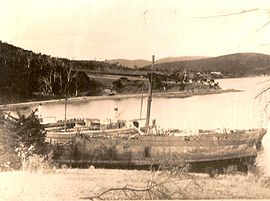Otago, Tasmania
|
Otago Hobart, Tasmania |
|||||||||||||||
|---|---|---|---|---|---|---|---|---|---|---|---|---|---|---|---|

Otago Bay and hulks including the Otago in the early 1950s
|
|||||||||||||||
| Coordinates | 42°48′3″S 147°17′28″E / 42.80083°S 147.29111°ECoordinates: 42°48′3″S 147°17′28″E / 42.80083°S 147.29111°E | ||||||||||||||
| Population | 556 (2011 census) | ||||||||||||||
| Postcode(s) | 7017 | ||||||||||||||
| LGA(s) | City of Clarence | ||||||||||||||
| Federal Division(s) | Franklin | ||||||||||||||
|
|||||||||||||||
Otago is a suburb on the eastern shore of Hobart, capital of Tasmania, Australia. It is located on the shores of Otago Bay. At the 2011 Australian Census the suburb recorded a population of 556.
The area takes its name from the iron barque Otago, the only command of the author Joseph Conrad, which was dismantled at a shipbreaking establishment that operated at the bay (formerly known simply as part of Old Beach) between the 1920s and 1960s. The remains of the Otago (beached there in 1931) and a steel river steamer the Westralian (beached in 1937) can still be seen on the beach.
...
Wikipedia

